

Pygmalion effect. More specifically, Rosenthal and Jacobson held that high expectations lead to better performance and low expectations lead to worse,[1] both effects leading to self-fulfilling prophecy.
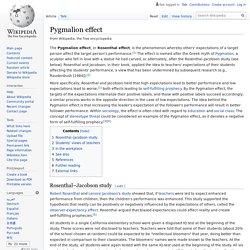
By the Pygmalion effect, the targets of the expectations internalize their positive labels, and those with positive labels succeed accordingly; a similar process works in the opposite direction in the case of low expectations. The idea behind the Pygmalion effect is that increasing the leader's expectation of the follower's performance will result in better follower performance. Within sociology, the effect is often cited with regard to education and social class. The concept of stereotype threat could be considered an example of the Pygmalion effect, as it denotes a negative form of self-fulfilling prophecy.[3][4] Rosenthal–Jacobson study[edit] Www.merriam-webster. The Psychology of Dreams: Inside the Dream Mind. Why do we dream?
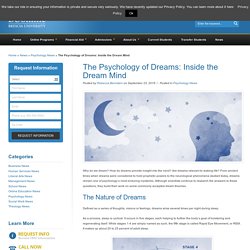
How do dreams provide insight into the mind? Are dreams relevant to waking life? From ancient times when dreams were considered to hold prophetic powers to the neurological phenomena studied today, dreams remain one of psychology’s most enduring mysteries. Although scientists continue to research the answers to these questions, they build their work on some commonly accepted dream theories. The Nature of Dreams Defined as a series of thoughts, visions or feelings, dreams arise several times per night during sleep. As a process, sleep is cyclical. The REM stage is the most common time of dreaming opens in new window, explains the National Sleep Foundation. In addition to its association with dreams, the REM stage is a time when the body processes information, creates memories and increases depleted chemicals, such as serotonin.
Carl Jung - Matter of Heart (1985) Hypothalamus. Schizophrenia found to be caused by faulty helper cells in the brain. New research on mice has suggested the symptoms produced by schizophrenia could largely be the result of defective cells that play an important role in supporting and insulating the nerve cells.
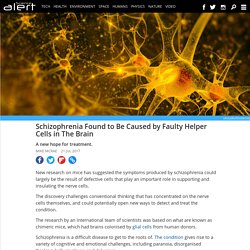
The discovery challenges conventional thinking that has concentrated on the nerve cells themselves, and could potentially open new ways to detect and treat the condition. The research by an international team of scientists was based on what are known as chimeric mice, which had brains colonised by glial cells from human donors.
Schizophrenia is a difficult disease to get to the roots of. The condition gives rise to a variety of cognitive and emotional challenges, including paranoia, disorganised thinking, hallucinations, and delusions. 21 million people worldwide have the condition, which has been shown to run in families. But as with many neurological conditions it's unlikely that there's a single cause responsible for producing the array of symptoms. John ridley stroop. Echoic memory. Akinetopsia. Panpsychism in the West (MIT Press): David F. Skrbina: 9780262693516: Amazon.com: Books.
Behavioral conditioning. Ecotherapy. Imprinting (psychology) Imprinting is used in psychology and ethology to describe any kind of learning that occurs at a particular age or stage of development.
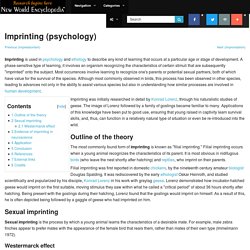
A phase-sensitive type of learning, it involves an organism recognizing the characteristics of certain stimuli that are subsequently "imprinted" onto the subject. Most occurrences involve learning to recognize one's parents or potential sexual partners, both of which have value for the survival of the species. Although most commonly observed in birds, this process has been observed in other species, leading to advances not only in the ability to assist various species but also in understanding how similar processes are involved in human development. Imprinting was initially researched in detail by Konrad Lorenz, through his naturalistic studies of geese.
The Jung Lexicon by Jungian analyst, Daryl Sharp, Toronto. A Primer of Terms & Concepts Copyright ©1991 Daryl Sharp All rights reserved.
Preface C. G. Jung died in 1961, without ever having presented a systematic summary of his psychology. Jung Lexicon takes the reader to the source. Jung Lexicon is not a critique or a defence of Jung's thoughts, but a guide to its richness and an illustration of the broad scope and interrelationship of his interests. Notes on Usage A word that appears in bold type under a main heading directs the reader to another entry.
The designation CW in the citations refers to the twenty volumes of Jung's Collected Works. Abaissement du niveau mental. It is a slackening of the tensity of consciousness, which might be compared to a low barometric reading, presaging bad weather. Abreaction. After some initial interest in "trauma theory," Jung abandoned abreaction (together with suggestion) as an effective tool in the therapy of neurosis. Abstraction. What Your Use of "Like", "You Know", and "Um" Says About You. What's the Latest?
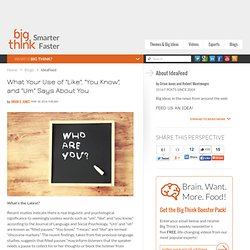
Recent studies indicate there is real linguistic and psychological significance to seemingly useless words such as "um", "like", and "you know," according to the Journal of Language and Social Psychology. "Um" and "uh" are known as "filled pauses. " "You know," "I mean," and "like" are termed "discourse markers.
" The recent findings, taken from five previous language studies, suggests that filled pauses "may inform listeners that the speaker needs a pause to collect his or her thoughts or block the listener from taking the speaker’s turn away. "